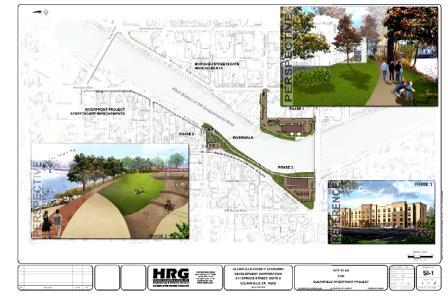CLEARFIELD – On Thursday night, Clearfield Borough Council heard from Fred Weaver, a local business owner and resident, who voiced opposition to the commercial development portion of the Clearfield County Economic Development Corp.’s (CCEDC) riverfront redevelopment project.
Weaver said his “central argument” against this project is that taxpayer money in the form of economic stimulus grants shouldn’t be used to create competition with private enterprise. “Owning and profiting from commercial real estate is a private enterprise,” he said.
“There’s a surplus of vacant commercial real estate here. I feel it’s a gross conflict of interest for an entity, such as the CCEDC, that purports to help economic development in this town, to instead help foster unnecessary competition for existing commercial real estate.”
According to him, it seemed that the borough has intentions to specifically “cater” to the commercial development in the riverfront project. He said the borough has helped by changing zoning, as well as adjusting parking requirements and traffic patterns. He believed the borough was making “special exceptions,” or spot zoning.
“I’m not a lawyer, but I found a Commonwealth Court ruling … spot zoning is ‘a singling out of a small lot or area for different treatment from that accorded to similar surrounding land indistinguishable from it in character for the economic benefit of the owner of that lot,’” said Weaver. “Spot zoning is against the law.”
Weaver said that he’s neither opposed to a park nor to private development. He noted that the CCEDC’s riverfront project is not entirely private development. In a meeting, Weaver said that borough representatives justified the construction of a commercial building along Water Street because developing the riverfront public park will negatively impact property taxes.
Based upon his math, the Water Street buildings, including the former Uni-Mart, pay $14,800 combined in annual property taxes. As comparison with the same equation, the Landmark building, located on Second Street, pays $14,600 and the new CVS Pharmacy pays approximately $22,000 in annual property taxes, he said.
Weaver said assuming the new commercial development on Water Street is between the size of the Landmark building and the new CVS Pharmacy, there will be an approximate net property tax increase of $5,000 annually.
In 2011, the CCEDC received grant funding to help with the renovations of the former Uni-Mart site, he said. Weaver added that at the time, it was “touted” with plans of housing 15 full-time jobs.
“Three years later, I only ever see four or five cars parked in the lot,” said Weaver, “and now the CCEDC intends to bulldoze it to help facilitate the construction of another commercial building on the adjacent site.” This, he said, didn’t make any sense and he wondered if the CCEDC even recouped the taxpayer costs in the form of rent, which to him didn’t seem likely.
During a planning commission meeting, he said Councilman Jim Kling insinuated there was a need for this commercial building along Water Street due to the demand created by the hotel to be constructed across the river. He said media reports have indicated that a hotel feasibility study was conducted by Core Distinction Group, which so far as his knowledge, has never advised against the construction of a hotel.
Upon further research, Weaver said he found a “troubling link” between Core Distinction Group and Cobblestone Inn & Suites, a company, which borough representatives have confirmed, was involved at some point. Cobblestone, Weaver said, habitually uses its sister company, BriMark Builders, to construct its hotels.
“While it isn’t illegal, it seems ethically questionable when a hotel chain comes into town, convinces the townspeople to hire a person who will surely say ‘a hotel is feasible’ and then essentially walks out with a sizable payday when their sister company is paid with money that’s rounded up for construction,” he said.
According to him, it’s been “rumored around town” that the CCEDC has already approached local businesses about relocating into the soon-to-be constructed commercial building along Water Street. This, he said, is “deeply troubling” because it’s not only creating competition for existing, vacant commercial real estate, but it’s also creating more vacant commercial real estate.
Weaver said while it’s fair in a free market by a private developer, the riverfront project isn’t an entirely private development. He said with the borough’s collusion with the CCEDC, it’s a case of the government “bending over backwards” to help a developer to the detriment of hardworking commercial real estate owners, which is unfair and wrong.
“If the CCEDC only poached six businesses currently paying $1,000 per month that is a $72,000 yearly negative impact on rents paid to current owners,” he said. “If the net increase in property taxes is only $5,000 a year, is that worth it? Build a park.”
He said in a meeting with borough representatives, the riverfront project’s previous developer was disparagingly described as a “used car salesman.” He said it was his feeling that the CCEDC is “simply a different used car salesman,” and this riverfront project “does nothing for economic development.”
Instead, Weaver suggested that the CCEDC has pushed out the Tool Shed and the Horizontal Drilling businesses. Additionally, he said it’s helped displace Water Street residents who were likely low-income and unable to easily afford to pick up and move into new apartments.
According to him, CCEDC Chief Executive Officer Rob Swales recently “touted” the commercial building as a facility to be used for special events, receptions and reunions. He pointed out that Clearfield has the Florian Banquet Center, Knights of Columbus, Moena and various other similar facilities. He asked if council members had discussed the need for competition with anyone from the said banquet facilities.
“My feeling is that this is a stupid, illegal and unfair plan, and one only to serve to line the pockets of the CCEDC,” said Weaver. “…The CCEDC is inept. Marketing is at the core of economic development.” He pointed out that in developing project plans, the CCEDC never secured a Clearfield river walk Web site.
He said the CCEDC in “all of its wisdom” paid $7,000 for a hotel feasibility study but never considered spending $18 yearly to secure the “most important, low-cost” form of national advertising available. “How do I know this? I bought it three weeks ago,” he said.
Weaver advised council to stop the commercial development of the riverfront project, which he believed puts them at risk of facing a spot zoning lawsuit. Instead, he said it needs to develop a park and then offer any leftover grant money back to the state. “That could be a great marketing coup. Be creative. Think. Do anything other than piggyback commercial development that hurts the townspeople who you represent,” said Weaver.
After the council meeting adjourned, Swales addressed claims made by Weaver during the public comment period. He said the borough isn’t spot zoning to facilitate the commercial development along Water Street, as it has comparable characteristics of existing zoning in the neighborhood.
So far as Weaver claiming the commercial development will create excess real estate, Swales pointed out that Pennsylvania Downtown Center statistics indicate typical vacancy rates of 30-40 percent in downtowns across the state. Downtown Clearfield, he said, has a vacancy rate below 10 percent and more than 200 businesses.
He also noted that the CCEDC didn’t own the Water Street properties at the time residents were displaced from them. In fact, he said the CCEDC facilitated for the men’s shelter to relocate into a building along Front Street that’s two-and-a-half to three times the size of its former location and in much better condition.
At the present time, Swales said the CCEDC doesn’t have plans to demolish the former Uni-Mart. He said it has plans to demolish two apartment buildings, the former men’s shelter and the Tool Shed site along Water Street.
The CCEDC’s hotel feasibility study was “very site specific,” said Swales. He said it examined local competition, hotel vacancy and occupancy rates within a multi-mile radius, local opportunities for growth and proximities to places, such as the hospital, fairgrounds, etc.
The commercial building, he said, will not be a “convention center,” which the CCEDC knows isn’t feasible in downtown Clearfield. He said it will be 10,000 square feet per floor at the very largest but has potential to be smaller.
Swales said that the first floor will house a restaurant/brewpub. The second-floor, he said, will be for multi-tenants for professional offices with common areas, such as a conference room, restroom, kitchen area, etc. The special events area, Swales stressed, will only be able to accommodate small training sessions, reunions and receptions and most commonly for single-day use.
Swales felt that perhaps the CCEDC was facing resistance with the riverfront project involving a private-public partnership, which is more common in larger cities. He said the hotel on the Tool Shed site will be on the tax rolls by a private developer and not owned by a government entity.
The CCEDC, he said, is facilitating the project by acquiring the land and demolishing the existing structure. He said it’s making it a “pad-ready” site for future development.
“We’re looking to bring in an entrepreneur to develop a hotel,” said Swales. “We’re looking at deeding the land over to the developer who will make a capital investment. [The CCEDC] then uses that as leverage to do the river walk project.”




